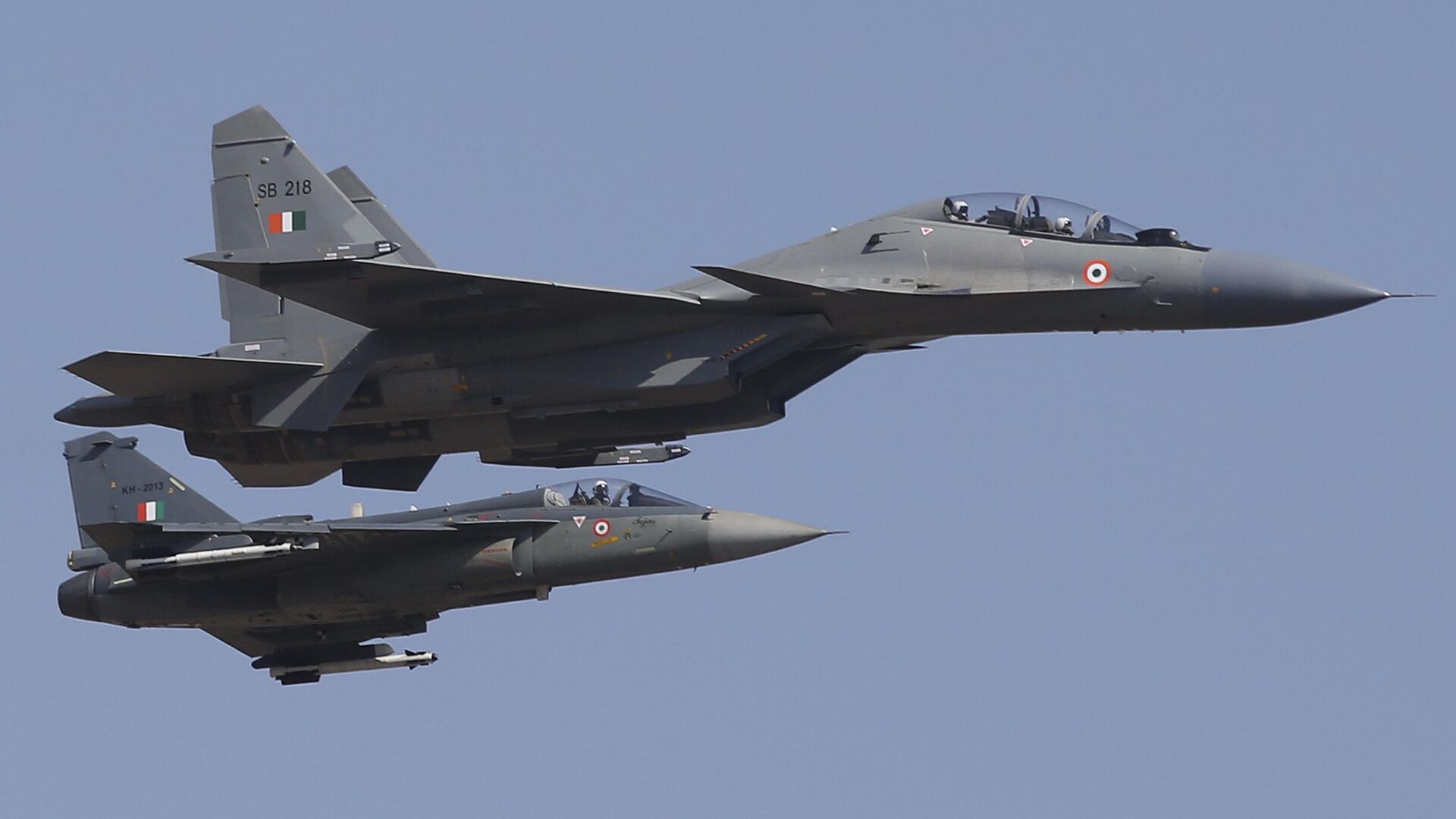https://sputniknews.in/20240223/indias-indigenous-anti-radiation-missile-rudram-iii-enhances-air-force-capabilities-6655238.html
India's Indigenous Anti-Radiation Missile RUDRAM-III Enhances Air Force Capabilities
India's Indigenous Anti-Radiation Missile RUDRAM-III Enhances Air Force Capabilities
Sputnik India
The Indian Air Force has completed modification of Su-30MKI aircraft to enable captive flight trials of the new generation anti-radiation missile RudraM-III.
2024-02-23T19:10+0530
2024-02-23T19:10+0530
2024-02-23T19:10+0530
defenсe news
science & tech
india
odisha
indian air force (iaf)
sukhoi su-30mki
military equipment
military spending
military cooperation
military build-up
https://cdn1.img.sputniknews.in/img/07e8/02/17/6650144_0:75:3304:1934_1920x0_80_0_0_f3c1dd715efadb20c16841e231dd92a7.jpg
The RUDRAM series marks India's first indigenous anti-radiation missile developed by the Defence Research and Development Organization (DRDO) for the Indian Air Force (IAF). Having demonstrated its capabilities, particularly in air-to-surface strikes, RUDRAM and RUDRAM-III are set to enhance the IAF's aerial prowess. The latest generation anti-radiation missile, RUDRAM-III, was successfully tested from the SU-30MKI fighter aircraft on October 9, 2020, at the Wheeler Island off the coast of Odisha. The SU-30MKI has long been a formidable combat aircraft for the Indian Air Force. Reportedly, RUDRAM-III weighs approximately 1.6 tons and can provide a remarkable range of around 600 km when launched from an altitude of 11 km, surpassing its predecessors RUDRAM and RUDRAM-II with a range of about 300 km. The initial plan is to integrate RUDRAM-III missile with the SU-30MKI, but in the coming days, there are plans to integrate it with Tejas-MK2, leveraging both variants of RUDRAM and RUDRAM-III. Dr. Nayan concluded, "Integration of RUDRAM-III missile with SU-30MKI and the indigenous Tejas-MK2 will be a strategic asset for the Indian Air Force. Advanced missiles with good range and accuracy are always installed in leading combat aircraft. These aircraft can venture into enemy territories and dismantle their positions without being detected by enemy radars. RUDRAM-III can target various objectives, including far-field radar installations, bunkers, airfields, and aircraft hangars."
https://sputniknews.in/20240220/india-launches-su-30mki-modernization-program-media-6617398.html
india
odisha
Sputnik India
feedback.hindi@sputniknews.com
+74956456601
MIA „Rossiya Segodnya“
2024
Sputnik India
feedback.hindi@sputniknews.com
+74956456601
MIA „Rossiya Segodnya“
News
en_IN
Sputnik India
feedback.hindi@sputniknews.com
+74956456601
MIA „Rossiya Segodnya“
Sputnik India
feedback.hindi@sputniknews.com
+74956456601
MIA „Rossiya Segodnya“
rudram, series, indigenous, anti-radiation missile, defence research and development organization, drdo, indian air force, iaf, air-to-surface strikes, capabilities, rudram-iii, associate fellow, mp-idsa, dr. rajeev nayan, parameters, successful tests, su-30mki, fighter aircraft, brahmos missile, range, precision strikes, tejas-mk2, integration, strategic asset, combat aircraft, adversary, radars, target, bunkers, airfields, aircraft hangars.
rudram, series, indigenous, anti-radiation missile, defence research and development organization, drdo, indian air force, iaf, air-to-surface strikes, capabilities, rudram-iii, associate fellow, mp-idsa, dr. rajeev nayan, parameters, successful tests, su-30mki, fighter aircraft, brahmos missile, range, precision strikes, tejas-mk2, integration, strategic asset, combat aircraft, adversary, radars, target, bunkers, airfields, aircraft hangars.
India's Indigenous Anti-Radiation Missile RUDRAM-III Enhances Air Force Capabilities
The Indian Air Force has completed modification of Su-30MKI aircraft to enable captive flight trials of the new generation anti-radiation missile RudraM-III.
The RUDRAM series marks India's first indigenous anti-radiation missile developed by the Defence Research and Development Organization (DRDO) for the Indian Air Force (IAF). Having demonstrated its capabilities, particularly in air-to-surface strikes, RUDRAM and RUDRAM-III are set to enhance the IAF's aerial prowess.
"India has already successfully tested RUDRAM-1 and RUDRAM-2. Each test is conducted based on specific parameters, and for a test to be considered successful, it must pass at least three times. For RUDRAM-III, specific parameters will be determined, and a set of new technology will be prepared for testing to observe its performance. If the results remain consistent after three consecutive tests, it will be deemed successful," Associate Fellow at MP-IDSA, Dr. Rajeev Nayan, told Sputnik India.
The latest generation anti-radiation missile, RUDRAM-III, was successfully tested from the SU-30MKI fighter aircraft on October 9, 2020, at the Wheeler Island off the coast of Odisha. The SU-30MKI has long been a formidable combat aircraft for the Indian Air Force.
Dr. Nayan elaborated, "While India has Tejas and Rafale, the SU-30MKI's capabilities surpass them, making it compatible with various missile systems. The BrahMos missile, for instance, was recently tested with the SU-30MKI. India can utilize these aircraft according to its mission requirements."
Reportedly, RUDRAM-III weighs approximately 1.6 tons and can provide a remarkable range of around 600 km when launched from an altitude of 11 km, surpassing its predecessors RUDRAM and RUDRAM-II with a range of about 300 km.
The addition of RUDRAM-III to the SU-30MKI and the indigenous Tejas-MK2 fighter aircraft will significantly enhance India's military capabilities, allowing for precision strikes against adversaries' strategic locations, even in heavily defended areas.
The initial plan is to integrate RUDRAM-III missile with the SU-30MKI, but in the coming days, there are plans to integrate it with Tejas-MK2, leveraging both variants of RUDRAM and RUDRAM-III.
Dr. Nayan concluded, "Integration of RUDRAM-III missile with SU-30MKI and the indigenous Tejas-MK2 will be a strategic asset for the Indian Air Force. Advanced missiles with good range and accuracy are always installed in leading combat aircraft. These aircraft can venture into enemy territories and dismantle their positions without being detected by enemy radars. RUDRAM-III can target various objectives, including far-field radar installations, bunkers, airfields, and aircraft hangars."


